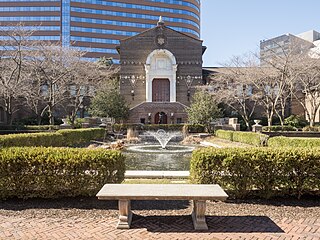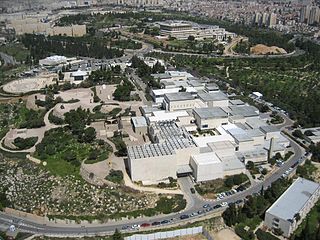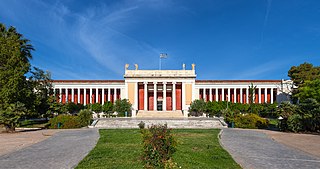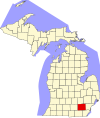History
The history of the museum begins before the museum was established. The founder of the university's collection of artifacts was Francis Kelsey, a professor of Latin at the University of Michigan from 1889 until his death in 1927. [3] [4] Kelsey began acquiring artifacts in 1893 in order to help his students understand the ancient world. [5] In 1893, he made his first acquisitions: 108 lamps, vases, and building materials from Alfred Louis Delattre, the Jesuit priest and archaeologist who was conducting an excavation at Carthage in Tunisia, and another 1,096 objects from dealers in Tunis, Rome, Capri, and Sicily. [5] Together with several thousand coins donated to the University of Michigan in the 1880s, these objects formed the core of the university's archaeological collections. [5] Kelsey continued to acquire objects (by gift and purchase) for the university until he died in 1927. [5] These artifacts included pottery, terracotta figurines, painted stucco, inscribed tombstones, daily life objects, glass, tombs, and papyri. [5]
In 1924, Kelsey secured funding for excavations at sites around the Mediterranean and began to ship a large number of artifacts back to Ann Arbor. [5] In 1924, he sent nearly 45,000 objects from Karanis, illustrating "in detail how daily life was lived in Egypt under Roman rule." [5] The same year, excavations at Seleucia-on-the-Tigris in Iraq yielded another 13,000 objects. [5] In 1925, Kelsey commissioned the Italian artist Maria Barosso to paint a set of watercolor replicas of the murals of the Villa of the Mysteries at Pompeii, which now are housed in a special room in the Upjohn Exhibit Wing. [5]
The building that now houses the museum was originally built for the Students' Christian Association for religious services and other meetings and activities. [3] It was designed by the Detroit architectural firm of Spier & Rohns. [6] Construction began in 1888 and was completed in 1891. [7]
The building is described as a "massive, asymmetrical Richardsonian Romanesque building of rough-cut, randomly placed local fieldstone." [6] [7] The building has a hip roof broken by parapeted cross-gables, with a facade "dominated by a projecting three-story corner turret topped by a conical roof"; "decorative colonettes, arches, and regularly coursed variegated brick bandcourses break the heaviness of the imposing stone structure." [6] The building was dedicated on July 21, 1891 at a cost of $40,000 and was named Newberry Hall—a name still engraved on the building's front—in honor of railroad magnate John S. Newberry, whose widow Helen Newberry contributed $18,000 toward the building's construction. [3]
The university leased Newberry Hall in 1921 for classroom space, housed its collection of ancient artifacts there from 1928, [3] [7] and finally purchased the building in 1937. [3] In 1953, the museum was named in honor of Kelsey. [3] [4] Newberry Hall was designated as a Michigan State Historic Site on August 13, 1971, and was added to the National Register of Historic Places on March 24, 1972. It is one of the oldest still-standing buildings on the University of Michigan campus. [7]
By the early 1990s the museum was experiencing overcrowding, deterioration of artifacts, and lack of adequate storage space. [7] It was closed in July 1993 for renovations and reopened in October 1994. [8] During that time, a new third floor was added in space formerly occupied by a choir loft (from the building's Christian Association period) and a new climate-controlled Sensitive Artifact Facility and Environment space was added to maintain "appropriate storage, humidity, and temperature requirements for optimal artifact longevity." [8] A new registry, conservation lab, objects study area, water-sprinkler fire control system, security system, and elevator to the new third floor were added. [7] [8] The building was also made more handicapped accessible. [8] The $1.3 million project was funded by a $250,000 gift from Eugene M. and Emily Grant of New York City, along with grants from the University of Michigan and the National Endowment for the Humanities, as well as funding from the Kelsey Museum Associates and other private contributions. [7] [8]
In 2003, Edwin and Mary Meader of Kalamazoo, Michigan, longtime benefactors of the university, gave an $8 million gift to expand the museum by the addition of a new wing in the back of the museum. [7] [9] At the time, this was the largest gift in the history of the College of Literature, Science, and the Arts. [9] The Meader gift, along with a $200,000 challenge grant from the National Endowment for the Humanities, covered all of the project's $8.2 million cost. [10] The Chicago-based architectural firm of Hammond Beeby Rupert Ainge Inc. designed the new addition. [10] In 2009, the William E. Upjohn Exhibit Wing was completed, adding more than 20,000 feet of study, storage, and display space in a climate-controlled facility; the new space allowed the museum, which previously had been displaying less than 1 percent of its collection, to dramatically expand the number of artifacts on public display. [3] [4] [7] [11] The wing was named after Mary Meader's grandfather William E. Upjohn, the noted pharmacist. [11] The building reopened to the public in November 2009. [12]

The Penn Museum is an archaeology and anthropology museum at the University of Pennsylvania. It is located on Penn's campus in the University City neighborhood of Philadelphia, at the intersection of 33rd and South Streets. Housing over 1.3 million artifacts, the museum features one of the most comprehensive collections of Middle and Near-Eastern art in the world.

The Michigan Relics are a series of alleged ancient artifacts that were "discovered" during the late nineteenth and early twentieth century. They were presented by some to be evidence that people of an ancient Near Eastern culture had lived in North America and the U.S. state of Michigan, which, is known as pre-Columbian contact. Many scholars have determined that the artifacts are archaeological forgeries. The Michigan Relics are considered to be one of the most elaborate and extensive pseudoarchaeological hoaxes ever perpetrated in American history.

The Israel Museum is an art and archaeology museum in Jerusalem. It was established in 1965 as Israel's largest and foremost cultural institution, and one of the world's leading encyclopaedic museums. It is situated on a hill in the Givat Ram neighborhood of Jerusalem, adjacent to the Bible Lands Museum, the National Campus for the Archaeology of Israel, the Knesset, the Israeli Supreme Court, and the Hebrew University of Jerusalem.

Samuel Abraham Goudsmit was a Dutch-American physicist famous for jointly proposing the concept of electron spin with George Eugene Uhlenbeck in 1925.

The Petrie Museum of Egyptian Archaeology in London is part of University College London Museums and Collections. The museum contains over 80,000 objects, making it one of the world's largest collections of Egyptian and Sudanese material. It is designated under the Arts Council England Designation Scheme as being of "national and international importance".

The National Archaeological Museum in Athens houses some of the most important artifacts from a variety of archaeological locations around Greece from prehistory to late antiquity. It is considered one of the greatest museums in the world and contains the richest collection of Greek Antiquity artifacts worldwide. It is situated in the Exarcheia area in central Athens between Epirus Street, Bouboulinas Street and Tositsas Street while its entrance is on the Patission Street adjacent to the historical building of the Athens Polytechnic university.

James Bennett Griffin or Jimmy Griffin was an American archaeologist. He is regarded as one of the most influential archaeologists in North America in the 20th century.

Gertrude Caton Thompson was an English archaeologist at a time when participation by women in the discipline was uncommon. Much of her archaeological work was conducted in Egypt. However, she also worked on expeditions in Zimbabwe, Malta, and South Arabia.

The Istanbul Archaeology Museums are a group of three archaeological museums located in the Eminönü quarter of Istanbul, Turkey, near Gülhane Park and Topkapı Palace. These museums house over one million objects from nearly all periods and civilizations in world history.

The Allard Pierson Museum is the archaeological museum of the University of Amsterdam. It is situated at the Oude Turfmarkt 127 in Amsterdam, the Netherlands. Artifacts from the ancient civilizations of ancient Egypt, the Near East, the Greek World, Etruria, and the Roman Empire are curated and exhibited in this museum.

Karanis, located in what is now Kom Aushim, was an agricultural town in Ptolemaic and Roman Egypt located in the northeast corner of the Faiyum Oasis. It was roughly 60 hectares in size and its peak population is estimated to be 4000 people, although it could have been as much as three times greater.
Tarrana, known in classical antiquity as Terenouthis, is a town that is currently referred to as Monufia Governorate of Egypt. This site is located in the western Nile Delta, circa 70 km north-west of Cairo, between the southern prehistoric site of Merimde Beni-salame and the northern town of Kom el-Hisn. The modern name for the necropolitain ancient city of Ternouthis (El-Tarrana) is Kom Abou Billou. Tarrana was once a popular commercial center, and housed a diverse demographic that erupted during the Graeco-Roman Period and the establishment of the Ptolemaic Period.

Tel Anafa is an archaeological site and nature reserve in the Upper Galilee, Israel.

The Archaeology Museum of the American University of Beirut in Beirut, Lebanon is the third oldest museum in the Near East after Cairo and Constantinople.

Aydın Archaeological Museum is in Aydın, western Turkey. Established in 1959, it contains numerous statues, tombs, columns and stone carvings from the Hellenistic, Roman, Byzantine, Seljuk and Ottoman periods, unearthed in ancient cities such as Alinda, Alabanda, Amyzon, Harpasa, Magnesia on the Maeander, Mastaura, Myus, Nisa, Orthosia, Piginda, Pygela and Tralleis. The museum also has a section devoted to ancient coin finds.
Elinor Mullett Husselman was an American Coptic scholar and papyrologist. She was Curator of Manuscripts and Papyrology at the University of Michigan Library and Curator of the Kelsey Museum of Archaeology for forty years, from 1925 to 1965.
Elisabeth R. O'Connell is a curator in the Department of Ancient Egypt and Sudan at the British Museum with responsibility for Roman and Late Antique collections. She is particularly known for her work on late antique Egypt and monastic communities.

Soknopaiou Nesos was an ancient settlement in the Faiyum Oasis (Egypt), located a few kilometers north of Lake Qarun.



















